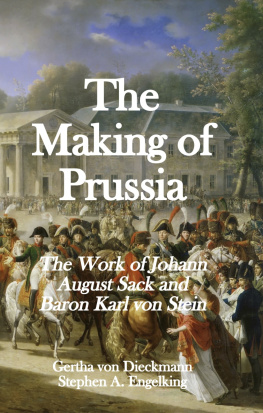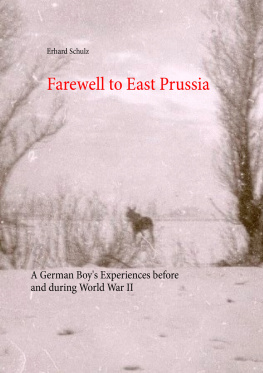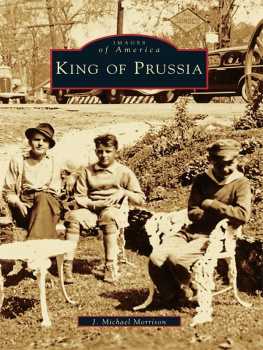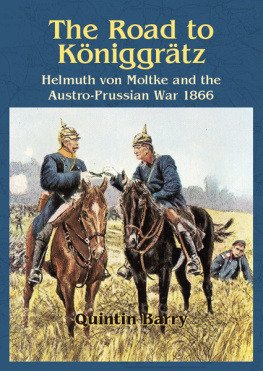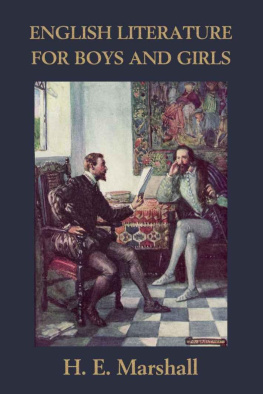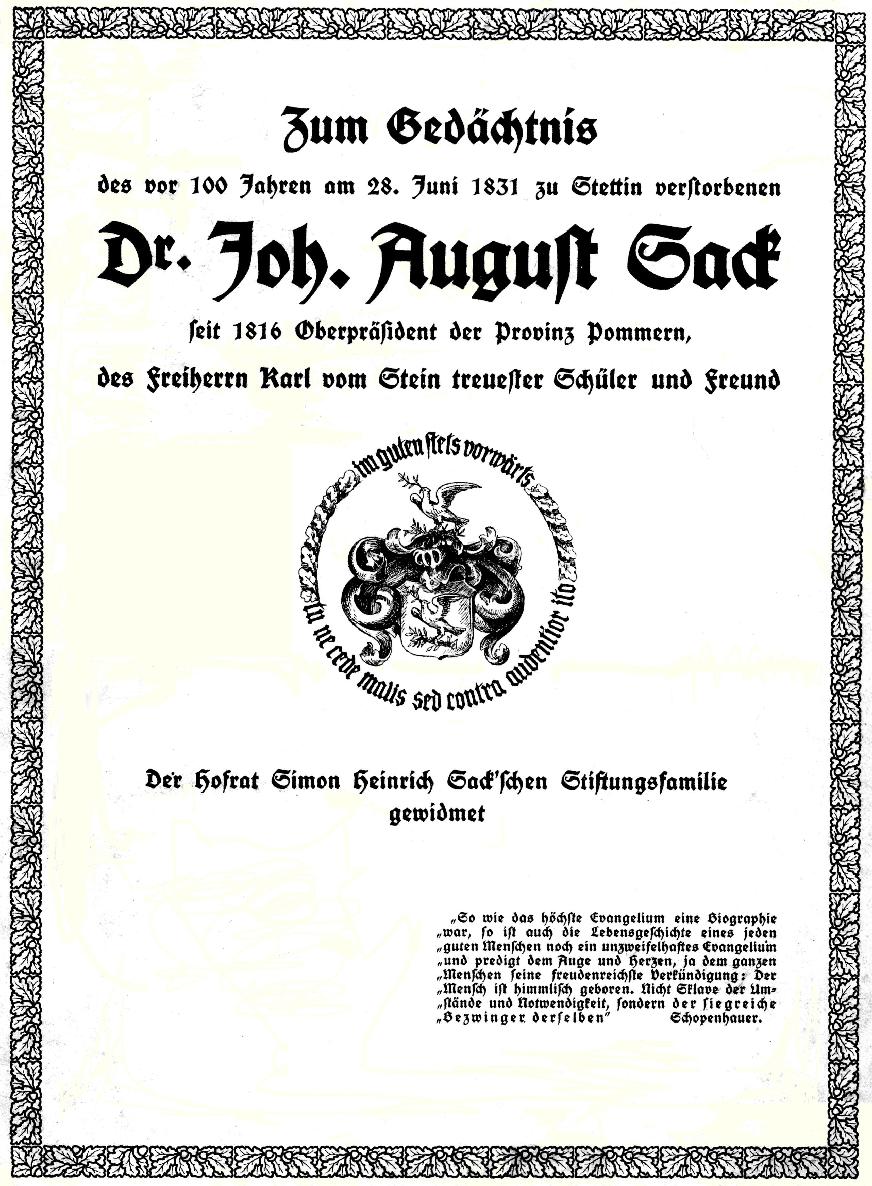The Making of Prussia
The Work of Johann August Sack and Baron Karl von Stein
Stephen A. Engelking & Gertha von Dieckmann
Texianer Verlag
Just as the greatest gospel was a biography, so the life story of every good man is still an unquestionable gospel, preaching to the eye and heart, indeed to the whole man, its most joyful proclamation: Man is born in heaven. Not a slave to circumstances and necessity, but the victorious conqueror of the same
Schopenhauer.
The Making of Prussia
The Work of Johann August Sack and Baron Karl von Stein
In Remembrance of
Dr. Johann August Sack,
who died 100 years ago on June 25, 1831 in Stettin, since 1816 Crown President of the Province of Pomerania and the most faithful student and friend of
Baron Karl von Stein
Dedicated to the Privy Councillor Simon Heinrich Sack Family Foundation
From the Book by Gertha von Dieckmann in German 1931 with additional notes and illustrations.
2020 Translated by Stephen A. Engelking
Texianer Verlag
www.texianer.com
Cover illustration: Entry of Napoleon I into Berlin, 27th October 1806 by Charles Meynier. (Public Domain PD-Art)
Foreword to this Edition
This monumental work by Gertha von Dieckmann found its fundament in her love and dedication for the cause of the Privy Councillor Simon Heinrich Sack Family Foundation a cause to which she dedicated her life.
She was also a very proficient writer and researcher of Prussian history and, whilst this book was primarily targeted at the audience to be found amongst the family members, it contains valuable insights into the Prussia of the early 19th century and details of the operation of the Prussian bureaucracy both under the time of the conquest of Napoleon and the efforts at rebuilding the structures of Prussia after his defeat. Much of the effort was carried out by the visionary leadership of the two characters which are portrayed in this book.
It paved the way for the modern society in Germany and was to influence the rest of Europe in the futureno less because of the considerable connections between these characters and England, Austria, Russia and France.
The original edition was set in old German Fraktur and in a large format. Initially I transcribed and edited the book completely into latin script to make it easier to commence the formidable task of translating into English. Some of the translation is particularly difficult because the documents go back into the eighteenth century and the meaning of many terms have been lost or forgotten. I would request the reader for forgiveness should the desire to lean in the favor of readability have introduced any oversights. For scientific research I would point the student to the original German text that has also been published by this house.
I have provided considerable additional notes to those provided in the original (marked with *) to assist the reader of English who may not be familiar with the Prussian customs and terms of the time. These have either been extracted from wikipedia.org or translated by me from wikipedia.de, unless otherwise stated. They are thus in the public domain and I would suggest that the interested reader might wish to search those sources for further information which would go beyond the scope of this book.
In addition to the illustrations provided in Gertha von Dieckmanns book, I have also added a number of illustrations which are in the public domain (PD-US) also sourced as above.
I have tried to retain the style of the original German whilst hopefully making this accessible to the modern English reader. I hope you will enjoy reading this piece of valuable historical literature.
Stephen A. Engelking
First Section
Original Frontispiece
Foreword by the Author
Having set myself the task of collecting everything that was available about him from within the circles of the Sack Family Foundation and from the life stories of the contemporaries of this immortalized man that were known to me, in order to commemorate the centenary of the death of this most important citizen. Because he has been given to the German fatherland by our Sack family in the 500 years of its proven ancestral line, I decided to lay a wreath of remembrance at his place of rest on June 28, 1931. I am well aware that my contribution can offer only a modest and very inadequate summary of the outstanding importance of that ardent admirer of the Fatherland and loyal official of his King, that fighter and servant for his German people and devoted friend of the fiery spirit Stein, with whom he worked tirelessly for 28 years in the closest possible cooperation for the preservation, promotion and liberation of Prussia from the yoke of French bondage. This latter accomplishment is expressed mainly in the first half of my compilation and at the same time, in order to be grateful to his former mentor, Baron Karl von Stein, who followed into eternity on the day after Joh. August Sack, June 1831, I conclude the first section with Steins official departure from the Prussian civil service. The second half of this commemorative volume, which will show Sacks independent leadership in the realization of the beneficial Stein transformations in the administration of the liberated fatherland, is to follow on his birthday on October 7 in this year or writing [now included with this edition]. This contains his work as Governor General and Crown President of the Rhine Province, as well as his 15 years of activity in the reorganization of the Province of Pomerania, as whose Crown President he dedicated his life.
In the first half of the historical events, I have taken into account the presentation of P. H. Pertz in his Steins Leben revealed to me the strangely heavy burden that Sack carried on his shoulders alone during his years as civil governor of Berlin and governor of the Kurmark, Neumark and Pomerania. As editor of the family magazine Die Taube , the treasure of letters from Dr. Joh. August Sacks estate, had once been given to me for publication, so I mostly used the articles which had already been published in Die Taube many years ago as family chronicles.
The second half is based on Neigebaurs written by Hermann von Petersdorf and various letters and Pomeranian local newspapers I received from the family. For all the kind assistance, especially for the photographs of the portrait of his wife, the house of his birth and the grave, I hereby express my most sincere thanks.
Should my small compilation happen to inspire a historian to write the detailed life story of Dr. Joh. August Sack, which has long been awaited in literary collections, it would be a particular success. My hope today is that it will create within the family of the foundation a double meaning. Its dove coat of arms was found in the letter seals of the Crown President in the form as reproduced from the title page. The coat of arms of cousin Captain Lieutenant Werner Reger, Kiel (No. 303 [1/4354]), is tastefully grouped around it as a wreath of remembrance, the upper one in youth, the lower one in later manhood, guiding this great citizen through life to strengthen and edify himself in the memory of this exemplary ancestor. This was at a time of a new threatening domination and enslavement and exorbitant taxation on the part of the French neighbor.
Note: The numbers behind names in brackets are those under which the members of the Privy Councillor Sack Family Foundation are listed in the family tree lists of 1926, in the second volume of the Silver Book of the Sack Family. [The translator of this edition has also added the new numbering system employed in recent editions of the Silver Book enclosed in square brackets].

